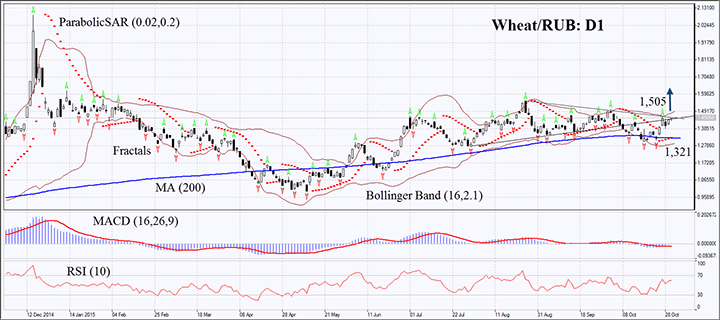By IFCMarkets
Global wheat prices have hit their 2-week high after the weekly record growth in 4 months amid the worse weather in its major growing areas. The Russian Ministry of Finance expects the seasonal ruble against dollar weakening in the end of this year. Will these factors encourage growth of ruble-denominated wheat prices?
We have studied the global wheat market in two Friday reviews (Market overview and Technical analysis), mentioning the possibility of its growth. As to ruble against dollar exchange rate, we can say that, on the contrary, it strengthened in November-December 2012. But in 2013-2014 the Russian currency was losing its value indeed. This year it is likely to repeat. On December 11 the next Bank of Russia meeting is to take place where the key rate may be changed. Its current level is 11%. The inflation in Russia was 11.2% since the beginning of 2015 to October 26. Nevertheless, several officials and businessmen believe the rate cut is essential. Firstly, the inflation growth has slowed down in the recent months. Secondly, the Bank of Russia alleged repeatedly that inflation will go down to 4% till 2017. If the rate cut will in fact happen in December, this will help to the ruble weakening and the growth of the personal composite instrument Wheat/RUB.

On the daily chart PCI instrument Wheat/RUB: D1 is in the uptrend above its 200-day moving average line. MACD and Parabolic indicators give buy signals. RSI is still far from its overbought zone but above 50. The Bollinger bands have widened which may mean higher volatility. They are tilted upwards. The bullish momentum may develop if the PCI price surpasses the upper Bollinger Band and three last fractal highs at 1506. This level can serve the point of entry. The initial risk-limit may be placed below the 200-day moving average and the Parabolic signal at 1.321. Having opened the pending order we shall move the stop to the next fractal low following the Parabolic and Bollinger signals. Thus, we are changing the probable profit/loss ratio to the breakeven point. The most risk-averse traders may switch to the 4-hour chart after the trade and place there a stop-loss moving it in the direction of the trade. If the price meets the stop-loss level of 1.321 without reaching the order of 1.506, we recommend cancelling the position: the market sustains internal changes which were not taken into account.
| Position | Buy |
| Buy stop | above 1,506 |
| Stop loss | below 1,321 |
Market Analysis provided by IFCMarkets